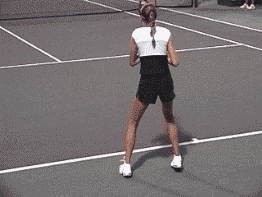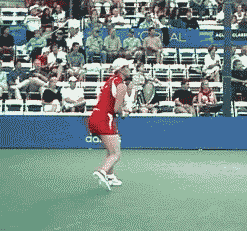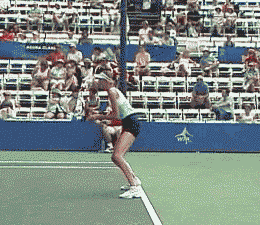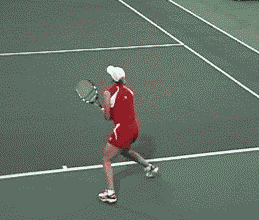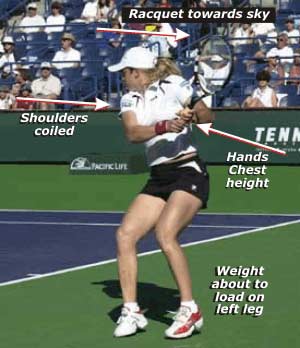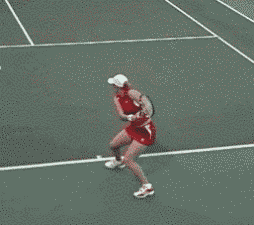|
TennisOne Lessons
Make Your Backhand Your Strength: Learn From Two of the BestBy Heath Waters
Whether you consider your backhand a detriment to your game or feel it is your biggest strength, you can learn a great deal from studying Kim Clijsters and Daniela Hantuchova, two of the best backhands in women's tennis. In this article I will break down the fundamental commonalities of these two great backhands into a 1, 2, 3 step easy to learn system and show you how to apply these fundamentals to your own backhand. While coaching full time on the professional tour the past 5 years, I have had the opportunity to see first hand, the best forehands and backhands in the world. I coach on both the ATP and WTA, but predominantly on the women's tour. This experience has brought me to the conclusion that, under pressure, men generally prefer to hit forehands while women prefer backhands. If you were to ask a male professional what shot they would like to hit when everything is on the line they would typically answer their huge topspin forehand. If you were to ask the women the same question you would get the opposite answer. They generally prefer to hit their “old reliable” two handed backhand. Remember, I said generally. The underlying principle behind this is quite simple, men are physically stronger and that enables them to more easily control the one handed forehand from a weakened position. For example; off balance or on the full run. Men simply wail at the ball and hit more topspin to compensate or they literally muscle the ball over the net.
When facing players with a lot of spin and power such as Serena, Venus, Davenport , Mauresmo, or Henin-hardenne, you will notice most women players will make more errors from the forehand side as it is much more difficult to handle the sheer power and spin coming from these power houses. The backhand however tends to be the steady rock that can weather big storms and even dish out some lightning of its own. So let's take a look at the technique of two of the best backhands in the world and show you how to apply their fundamental commonalities to your own game. I am going to break Clijsters' and Hantuchova's backhand techniques down into three easy to learn steps:
You can then copy their techniques step by step and apply it to your own backhand. Step One - The Preparation Let's examine the fundamental commonalities of Clijsters and Hantuchova share during the preparation The first thing you should note is that before each backhand the players split step and simultaneously coil the torso. As they coil and take the racquet back, they go into what I will call position number one. This is the final preparation position you will want to achieve. It is important to understand that when taking the racquet back, it should be done with the turning of the body and not solely with the arms. The racquet simply moves in unison with the coil of the body. The objective here is to mimic the final preparation position of Clijsters and Hantuchova and get the body and racquet into the same fundamental positions they do. The key focal points to note are: The torso, which is coiled, the racquet head position, which is pointing upwards toward the sky, the hands which are set near chest height, and the the left leg which is loaded or in the process of being loaded supporting 100% of the players weight. In the examples above a closed stance is used with both knees slightly bent, and a good wide base is achieved for maximum balance. This means in the final number one position your feet should be set more than shoulder width apart. So stand up, get your racquet, and practice getting into position number one, preferably in front of a mirror, and see if your final preparation position looks like Clijsters' and Hantuchova’s.
Step two - The Hitting Zone Once you have achieved the proper final preparation position, begin your swing through the hitting zone. I call this position number two. Relax your body and arms and let the racquet begin to fall downward until it is approximately one racquet head length below the flight path of the incoming ball. How far you drop the racquet head below the ball depends on how much spin you want to generate. In the examples below, notice that Hantuchova is almost a full racquet head below the ball right before contact and Clijsters is a bit further below that. This means when struck, Hantuchova's ball will have slightly less topspin than Clijsters. If they intended to hit a flat ball (one with very little top spin), during the swing, the racquet head would have remained more or less on the same level as the flight path of the incoming ball without dropping much at all. The more the racquet head drops below the ball before contact, the more topspin can be generated. While swinging through the hitting zone, use only enough energy to complete the motion within the form. The racquet is propelled into the hitting zone by pulling the racquet down onto the level of the ball (or below the level if hitting topspin) with the left hand for right handers and the right hand for left handers (not the lead hand). The most important thing to focus upon while executing a great backhand technique is the contact point. Notice the height of the ball at which Hantuchova and Clijsters make contact; it's exactly at waist height level. This is the optimal contact point for achieving maximum power. If you were to watch a complete match of Clijsters and Hantuchova you would be hard pressed to ever see them hit a backhand higher than waist height or lower than knee height.
Next, note the position of the ball in relation to the body at contact. Both players contact the ball out in front of their bodies almost exactly at their right foot with the left arm almost completely straight at contact. This is a great reference point to kinetically feel for when making contact. Lastly notice how still the head and shoulders are at contact, the eyes are fixed on the ball and the shoulders are level or parallel to the ground. It is important to keep the body, head, and shoulders quiet throughout contact as this will ensure optimal balance and enhance visual acuity (how well you see while in motion). The only thing moving during actual contact should be the racquet, arms, and ball assuming the ball was hit to your comfort zone and you are able to properly set up. About the only time these fundamental commonality reference points are compromised is when these players hit a poor backhand from a weakened position. The secret to consistency in all strokes is to make contact with the ball at the same height and at the same distance from the body each and every time. I call this equi-height (off the ground) and equi-distant (from the body) contact attainment. This is the secret to consistency in all strokes. Step three - The Ending As soon you feel the ball make contact with the strings, immediately let the racquet flow into position number three, the stroke ending. To mimic Clijsters' and Hantuchova's topspin backhand ending, finish with your weight transferred completely onto your right foot, the racquet head should end over the shoulder with your left elbow pointing towards the target, and the racquet head pointing directly behind you. Clijsters wraps her racquet a bit more around her neck than Hantuchova who has a slightly more compact finish. Once you have completed the transfer of weight into your shot, the left foot will naturally flow forward and land parallel (preferably) to your right foot ready to split step and start the process all over again. So that's it. The fundamental commonalities of two of the best backhands in women's tennis, put neatly into a 1, 2, 3 step system, one that can be easily understood and mimicked. Now it's up to you to put the three steps all together. Get in front of a mirror and examine your preparation, contact point, and ending and stop and observe each step. When you feel you have copied the exact 1, 2, 3's of Clijsters and Hantuchova, put the three steps together at the same time. Once you have that down, videotape yourself and compare your backhand to the pros, then refine your technique. Follow this course of action and pretty soon you'll have a world class backhand technique just like Daniela Hantuchova and Kim Clijsters. Your comments are welcome. Let us know what you think about
Heath Waters' article by emailing
us here at TennisOne.
|
|||||||||||

